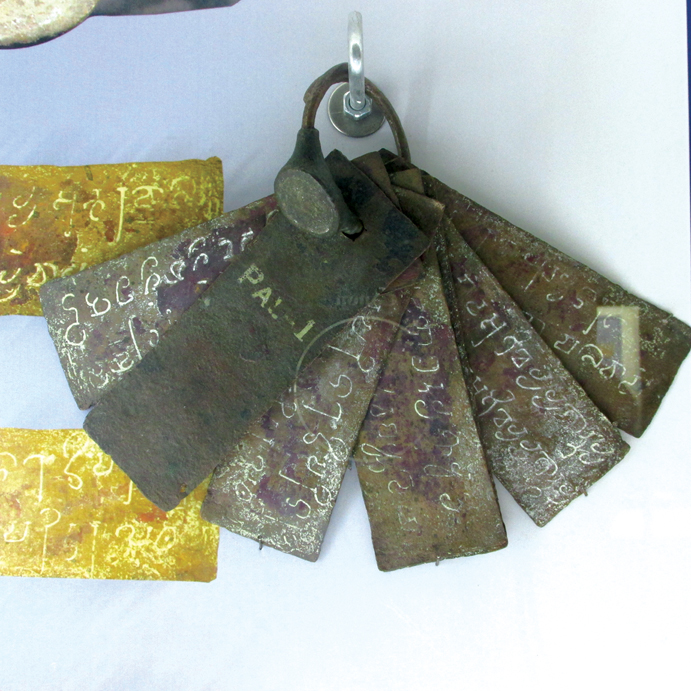Registered with the Registrar of Newspapers for India under R.N.I 53640/91
Vol. XXVIII No. 5, June 16-30, 2018
Museum’s wealth of inscriptions
by Dr. Chithra Madhavan

The Pallava copper-plate inscriptions
Visitors to the Madras Gov-ernment Museum on Pantheon Road, Egmore, usually make a beeline for the Bronze sculpture section which has on display some of the most magnificent metal images ever created. These visitors also go to the gallery which houses stone sculptures, but hardly anyone takes the effort to go to a separate section which has a superb collection of copper-plate inscriptions which date from the 4th Century C.E. right down to British times.
Those who do visit this gallery have their eyes glued to the huge Chola copper-plate records, quite awed by their sheer size. But lovers of history and heritage must pay attention to the oldest inscriptions here, which are of the Pallava times. The earliest copper-plate epigraph is the Maidavolu record which has been dated c.305 C.E. The eight copper plates are strung on a copper ring held together with an elliptical copper seal which has the figure of a bull and the name ‘Sivaskandavarmanah’ etched on it but which is partially worn out. The bull was the famous emblem of the Pallavas and the name is of the Pallava king of the 4th Century C.E. Most visitors peering at this inscription, trying to read it, will be bewildered as they will understand neither the language, which is Prakrit nor the script, which is Brahmi.
This set of copper-plates found in 1899 by a man who was digging a field in an abandoned village north of Maidavolu in Guntur District, Andhra Pradesh, were subsequently presented to the museum by Maidavolu Jayarammaya, the owner. The contents of this important inscription were published in Epigraphia Indica Volume VI by E. Hultzch, a German Indologist and first Chief Epigraphist when the Epigraphy Department of the Archaeological Survey of India was first formed in 1886.
This informative record mentions that an order by King Sivaskandavarman was issued from Kanchipura, which many scholars have identified as the present-day Kanchipuram, and some have identified as a place in Andhra Pradesh. This royal order was addressed to the king’s official at Dhannakada (present-day Amaravati) conferring the gift of a village Viripura to two scholars. It mentions that the land thus donated, was exempted from ‘digging for salt, entrance of soldiers, supply of boiled rice, water pots, cots and dwellings…’ Transgressors of this edict were liable to bodily punishment, says the inscription.
Another set of five copper-plates, dated c.338 C.E. also strung together on a copper ring, has a similar seal. They were bought from Chennappa, a merchant in Hirahadagalli (Bellary District) and deposited in the museum by the Archaeological Survey of India. This too is in the Prakrit language and in the Brahmi script used by the early Pallavas. This inscription is dated the fifth day in the sixth fortnight of the rainy season in the eighth year (possibly the eighth year of King Sivaskandavarman’s reign) – what meticulous documentation! Again issued from the same Kanchipura, it mentions that Sivaskandavarman, who was a performer of sacrifices such as the famed Ashwamedha, confirmed and enlarged a grant of garden-land to specified scholars declaring it ‘free from supplying food, water, firewood and other commodities to officers… and free from troubles by officials’! The Hirahadagalli copper-plate inscription also goes on to give a list of officers, which information has been most useful to historians such as Dr. C. Minakshi, the famous scholar of Pallava history, in documenting administrative life in the Pallava times.
Another important Pallava epigraph on display is the Kuram copper-plate inscription, which historians and archaeologists are very familiar with. This record is from historic Kuram village, close to Kanchipuram, which also has a Siva temple of Pallava times. Bought from the Dharmakarta of this place, it consists of seven copper plates of which the first, fifth and sixth plates are worn out and half of the seventh plate is missing. The copper ring has the bull emblem, the moon and other symbols. Belonging to the reign of King Parameshwara Varman I Pallava of the 7th Century C.E., this bilingual inscription is half in Sanskrit, etched in the famed Pallava Grantha script, and the second half in Tamil. The lineage of the Pallavas, especially the many victories of Narasimhavarman I (Mamalla) against the Chalukya ruler Pulakesin and also the Cholas, Pandyas and others, given in detail in this record are pieces of information which have been incorporated into books by scholars on South Indian history. The donation of a village named Parameshwaramangala to the Siva temple in Kuram and to scholars who studied the Vedas is the object of this historical document which lists the break up of the land into shares allocated for various purposes. The different taxes payable to the government and water management in the village by way of a channel dug from River Palar leading to a large tank at Parameshwaramangalam (near Chengalpattu) are also detailed here.
These early copper plate inscriptions of the Pallavas go to show that Prakrit was widely used in the Tamil country, and was perhaps even the court language and that the Brahmi script, usually associated only with the inscriptions of Asoka, the Mauryan Emperor, was also used extensively in the South. Also to be noted is the important fact that there was a keen sense of documenting information in ancient India – the minute details of place of issue, time, and a multitude of other data point to this.
The challenge lies in getting across the importance of these inscriptions to visitors to the museum.

